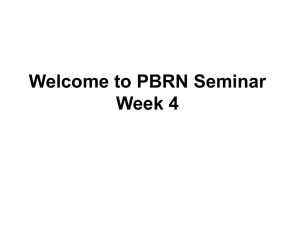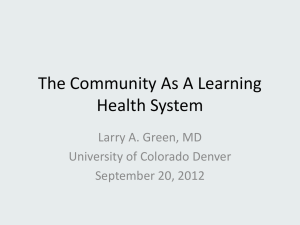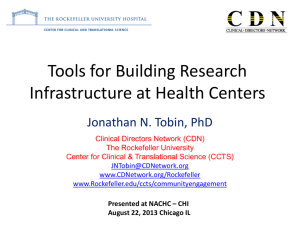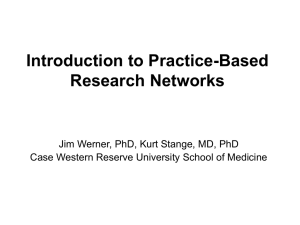Welcome to PBRN Seminar Week 3
advertisement
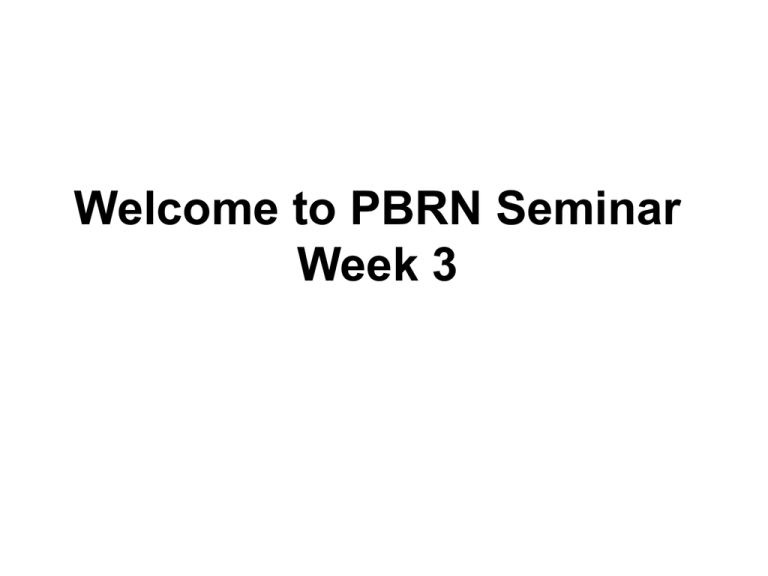
Welcome to PBRN Seminar Week 3 To this point… What are PBRNs? What do PBRNs do? Why are PBRNs important? What are the key components of PBRNs? How do PBRNs function? Tonight • Dr. Ann Reichsman Director, Safety Net Providers Strategic Alliance PBRN (SNPSA) – What are the steps in developing a PBRN? – How do PBRNs maintain the interest and involvement of clinicians? – What is the value of PBRN research to clinician-members? Also tonight… • How generalizable are PBRN research findings to non-PBRN practices? How Representative are PBRN Practices and Patients? Jim Werner, PhD CTSC PBRN Shared Resource Case Department of Family Medicine Why Practice-Based Research is Needed 1000 persons 800 report symptoms 327 consider seeking medical care 217 visit a physician’s office (113 visit a primary care physician’s office) PBRN Research 65 visit a complementary or alternative provider 21 visit a hospital outpatient clinic 14 receive home health care 13 visit an emergency dept 8 are hospitalized <1 is hospitalized in an academic medical center Most Research Results of a reanalysis of the monthly prevalence of illness in the community and the roles of various sources of health care. Green LA et al., N Engl J Med 2001, 344:2021-2024. How well does research generated in PBRN practices generalize to the larger population of ambulatory practices across the country? Determine a baseline for ‘typical’ ambulatory health care in the U.S. Determine a baseline for ‘typical’ health care delivered by PBRN practices in the U.S. Compare patient populations and clinician practice patterns National Center for Health Statistics • • • • • • • • • • • • • Ambulatory Health Care Data (NAMCS/NHAMCS) National Health Interview Survey National Health Interview Survey on Disability National Health and Nutrition Examination Survey (NHANES) National Health Care Survey Hospital Discharge and Ambulatory Surgery Data National Home and Hospice Care Survey National Nursing Home Survey National Employer Health Insurance Survey National Vital Statistics System National Survey of Family Growth National Immunization Survey The Longitudinal Studies of Aging (LSOAs) http://www.cdc.gov/nchs/ National Ambulatory Medical Care Survey (NAMCS) • A national survey designed to meet the need for objective, reliable information about the provision and use of ambulatory medical care services in the United States. • Findings are based on a sample of visits to nonfederally employed office-based physicians who are primarily engaged in direct patient care. • Physicians in the specialties of anesthesiology, pathology, and radiology are excluded from the survey (all others are included). National Ambulatory Medical Care Survey (NAMCS) • Each year, data is captured for 3,000 randomly selected ambulatory visits • The survey has been conducted annually from 1973 to 1981, in 1985, and annually since 1989. • Data are widely used by health care researchers, policy analysts, congressional staff, the news media, etc. Methods for NAMCS • Trainers visit the physicians prior to their participation in the survey to provide them with survey materials and instruct them on how to complete the forms • Each physician is randomly assigned to a 1-week reporting period. Data for a systematic random sample of visits are recorded by the physician or office staff on an encounter form Data Elements for NAMCS • • • • • • • • • • • • • Patient information Injury/Poisoning/Adverse Effect Reason for visit Continuity of care Provider’s diagnosis for this visit Vital signs Diagnostic/screening services Health education Non-medication treatment Medications & immunizations Providers Disposition Time spent with provider How Representative of Typical Practice are PBRN Patients? • Methods – 83 physicians in 44 primary care PBRN practices were randomly assigned to 1 of 52 weeks for data collection (replicated NAMCS) – The PBRN sample was statistically compared with NAMCS sample that was collected at approximately the same time Green LA, Miller RS, Reed FM, Iverson DC, Barley GE. How representative of typical practice are practice-based research networks? A report from ASPN. Arch Fam Med 1993(2):939-949. Similarities • Substantial similarities between the PBRN & NAMCS samples in… – Patient characteristics – Reasons for visits – Diagnoses – Diagnostic tests – Therapies prescribed – Time spent with patients – Patient disposition Green LA, Miller RS, Reed FM, Iverson DC, Barley GE. How representative of typical practice are practice-based research networks? A report from ASPN. Arch Fam Med 1993(2):939-949. Differences • The PBRN reported the following minor differences vs. NAMCS… – More patients with HMO & private health insurance – More visits for preventive care – More diagnoses of depression & anxiety – Greater percentage of white patients – More PBRN practices were located in rural settings Green LA, Miller RS, Reed FM, Iverson DC, Barley GE. How representative of typical practice are practice-based research networks? A report from ASPN. Arch Fam Med 1993(2):939-949. Conclusions • Findings suggest that patient visits to PBRN physicians were sufficiently representative of those made to primary care physicians nationally • Areas of difference point to potential biases that may impact the interpretation of findings How Accurately do PBRN Clinicians Represent Other Clinicians? • Comparison between NAMCS and PBRN replication of NAMCS • Examined the practice patterns of 129 primary care physicians (mostly Family docs) in 52 PBRN practices • Compared 3192 PBRN visits with 3713 NAMCS visits Nutting PA, Baier M, Werner JJ, Cutter G, Reed FM, Orzano AJ. Practice patterns of family physicians in practicebased research networks: a report from ASPN. Ambulatory Sentinel Practice Network. J Am Board Fam Pract. 1999;12:278-284. How Representative of Typical Practice are PBRN Clinicians? • Primarily interested in how PBRN physicians might differ in screening, prescribing, diagnostic, and therapeutic services (20 clinical services) • Used nested statistical models to account for multiple patient visits per physician • Adjusted for patient age, sex, race, ethnicity, method of payment, physician age and sex, rural/non-rural, primary reason for visit, duration of visit, season of visit Nutting PA, Baier M, Werner JJ, Cutter G, Reed FM, Orzano AJ. Practice patterns of family physicians in practicebased research networks: a report from ASPN. Ambulatory Sentinel Practice Network. J Am Board Fam Pract. 1999;12:278-284. Findings • Of 20 clinical services, 4 predicted membership in the PBRN, 16 did not • Screening and diagnostic: – PBRN docs 1.18x more likely to obtain blood pressure – PBRN docs 0.60x as likely to order a strep culture • Counseling: – PBRN physicians 2.30x more likely to provide family planning counseling – PBRN docs 1.66x more likely to provide smoking cessation counseling after adjusting for smoking status Nutting PA, Baier M, Werner JJ, Cutter G, Reed FM, Orzano AJ. Practice patterns of family physicians in practicebased research networks: a report from ASPN. Ambulatory Sentinel Practice Network. J Am Board Fam Pract. 1999;12:278-284. Conclusions • There appear to be minimal differences in the practice patterns PBRN physicians vs. NAMCS probability sample • Analysis limited to the service variables included in NAMCS Nutting PA, Baier M, Werner JJ, Cutter G, Reed FM, Orzano AJ. Practice patterns of family physicians in practice-based research networks: a report from ASPN. Ambulatory Sentinel Practice Network. J Am Board Fam Pract. 1999;12:278-284. Interpretation • Study 1: PBRN primary care patients are similar to patients nationally • Study 2: PBRN primary care physicians have similar practice patterns to physicians nationally • No study population is perfectly generalizable • Clinicians should assess the relevance & transportability of findings of a particular PBRN study to their own settings Stange KC. Practice-based research networks: Their current level of validity, generalizability, and potential for wider application. Arch Fam Med 1993 (2) 921-923. In spite of all this… It seems possible that PBRN physicians may practice differently than non-PBRN physicians. Why might PBRN Physicians be Different? • PBRN members may be more critical in their reading and analysis of evidencebased clinical guidelines • The resulting differences in knowledge, attitudes, and beliefs can result in different practice patterns and services • These physicians could attract patients who differ from the general population Nutting PA, Baier M, Werner JJ, Cutter G, Reed FM, Orzano AJ. Practice patterns of family physicians in practice-based research networks: a report from ASPN. Ambulatory Sentinel Practice Network. J Am Board Fam Pract. 1999;12:278-284. What does this mean for PBRN Research? • Studies of physician behavior may be affected • Studies of patient characteristics seem less likely to be affected Stange KC. Practice-based research networks: Their current level of validity, generalizability, and potential for wider application. Arch Fam Med 1993 (2) 921-923. What does this mean for generalizability? • No study population is perfectly generalizable • It is important to assess the relevance & transportability of findings of a particular PBRN study to other settings Stange KC. Practice-based research networks: Their current level of validity, generalizability, and potential for wider application. Arch Fam Med 1993 (2) 921-923. Implications for PBRN Development • Since PBRN-member clinicians may be ‘at risk’ for developing different practice patterns, offering various levels of network membership may be beneficial • Continual expansion of PBRNs may protect against developing an insular group of practices who influence one another and who are changed by their interactions Questions? Next Week • Data collection methods in PBRNs – Electronic data collection methods • Louise Acheson, MD, MS – The “Card Study” method – Frequently used data collection tools
